Soft Sourdough French Bread
As a teenager I lived in the San Francisco Bay Area. I used to always add loaves of French bread to the grocery list from our local grocery store. It was light, fluffy and was easily one of my favorite breads of all time. That bread, however, doesn’t exist in many parts of the U.S. so I decided to make my own loaf of French bread using 100% sourdough starter and no commercial yeast in sight. While the end product doesn’t taste exactly like the Bay Area store-bought version (which undoubtedly has commercial yeast, dough enhancers, etc…), it is a stand-alone delicious sourdough french bread in its own right. This sourdough french bread is initially a little crispy on the outside. As it cools it softens and you cut into a tender, light and just slightly tangy inside. With just a few simple ingredients and an active sourdough starter, you can have this bread on your dinner table too
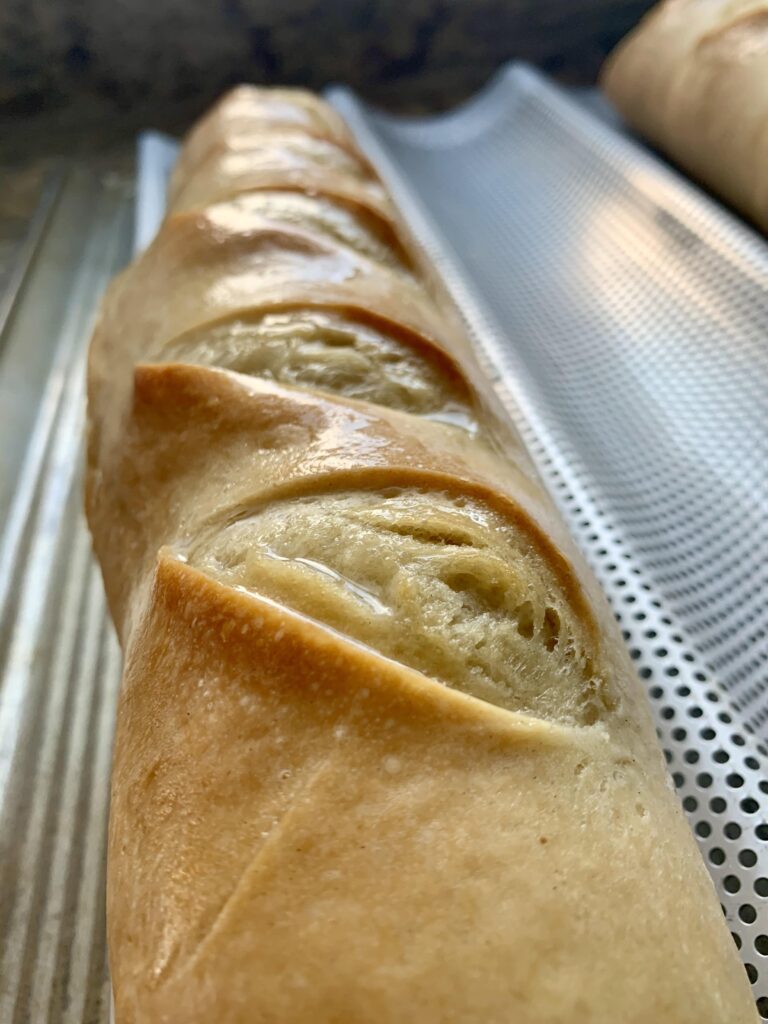
A Sample Timeline: Sourdough French Bread
A sample baking schedule helps me when baking with sourdough. Sourdough takes much longer to rise than commercial yeast bread. This schedule helps me plan my bake. A note: This schedule assumes the dough temperature is 78-80°F throughout the process.
| Day 1 | |
| 8:00 PM-8:00 AM | Mix Levain. Cover and ferment at 78ºF about 10- 12 hours until doubled, bubbly and ripe |
| Day 2 | |
| 8:00 AM | Knead dough |
| 8:15 AM – 12:15 PM | Bulk Fermentation |
| 12:15 PM – 12:30 PM | Divide and shape |
| 12:30 PM – 4:30 PM | Proof in warm 80-85ºF place |
| 4:30 PM – 5:00 PM | Bake: ONLY once the dough has doubled in size and risen until light and puffy. If the dough is too cold, it won’t rise quickly – move it to a warmer location and wait for the bread to rise. Don’t bake the bread is light, fluffy, airy and doubled in size. |
How to Make Sourdough French Bread
Mix the Levain
This recipe calls for a sweet levain mixed the night before you mix the dough. It is fed at a 1:10:10 ratio, which allows you to mix it up in the evening and then use it in the morning. You can change up the ratio as needed to fit better in your schedule. If you keep the levain at 78-80ºF, it should take 10-12 hours to rise and peak. Levain is ready when it has at least doubled in size, has lots of bubbles, a slightly sour aroma and is just about to start going down from its peak height. Mix together:
- 11 grams ripe/mature starter
- 110 grams warm water
- 110 grams all-purpose or bread flour
If you prefer to substitute ripe sourdough starter for the levain, this can work. Make sure your starter is 100% hydration (fed equal weights of flour and water) and is active and bubbly before using. Substitute for the levain in the recipe. You can also use this post on ratios to change up the ratio of feeding the levain to make it work for you and your schedule.
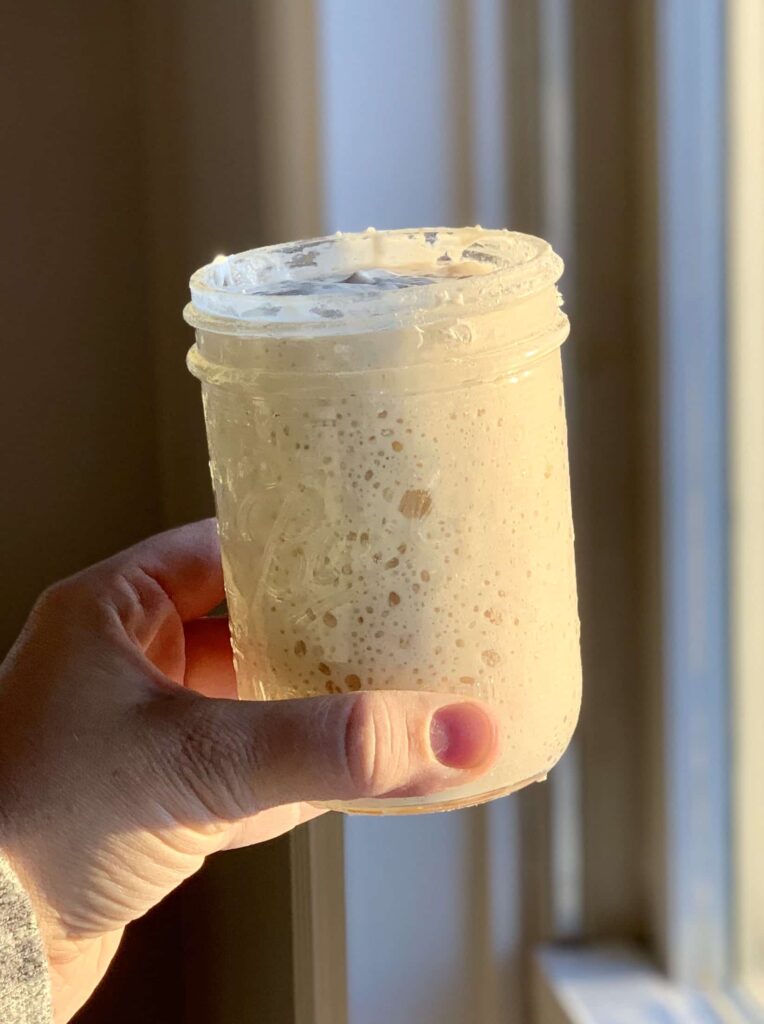
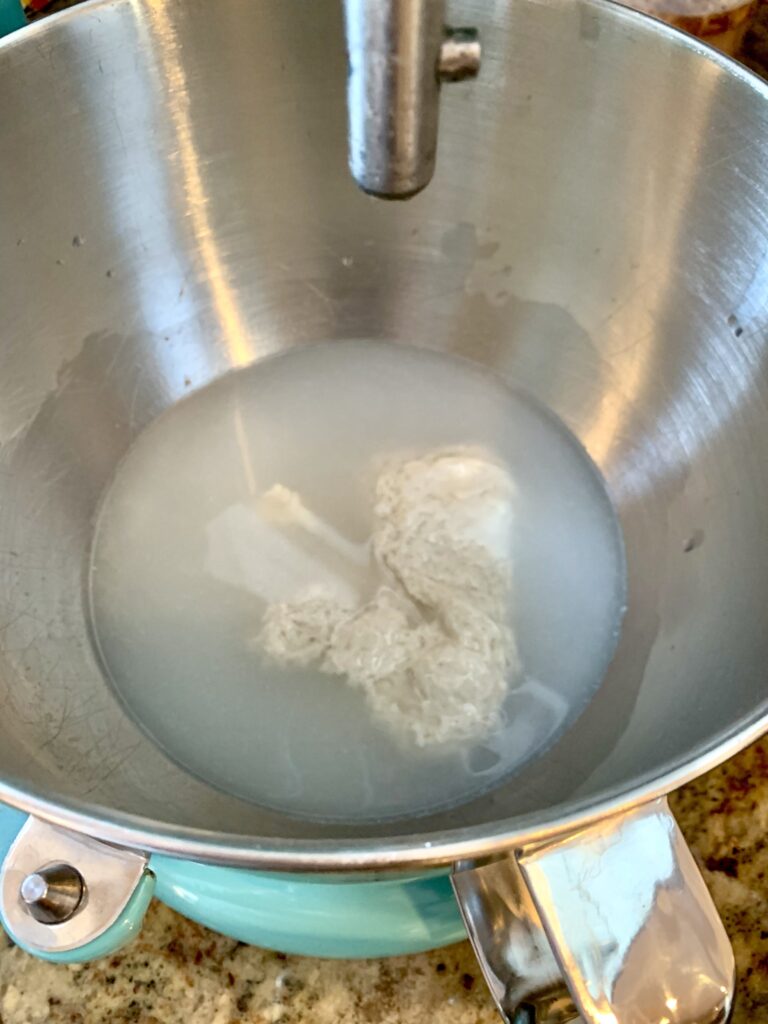
Mixing Soft Sourdough French Bread Dough
To the bowl of a stand mixer, add the ripe levain, sugar, warm water, oil, salt and bread flour. Mix for about 10 minutes until the dough is tacky and strong. Remove dough to a bowl or container. Cover with a plastic shower cap (the best tip!) or a kitchen towel and place in a warm place (78-80ºF) for bulk fermentation.
Pro Tip: The temperature of the water can have an effect on how quickly the sourdough ferments. If you are baking this bread in the summer, you may want to use cooler water to balance out the warmer ambient temperature in your kitchen. If you bake during the winter, a warmer water (nothing over 98 degrees–temperature of baby’s bath) can help increase the activity and fermentation process of the natural yeast.
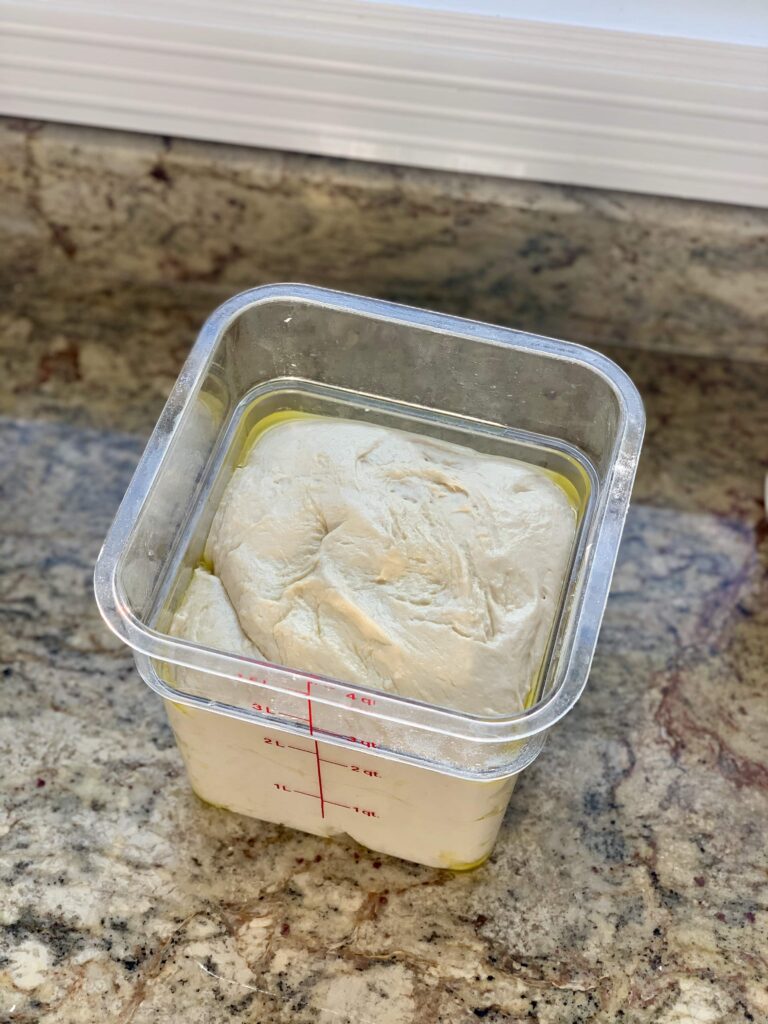
Bulk Fermenting Sourdough French Bread
Total bulk fermentation should be about 4 hours, with the dough’s internal temperature staying around 78-80ºF throughout the bulk rise. You are looking for the dough to become aerated and rise just a bit before proceeding to shaping the dough. Note: the dough will not have risen much, but should have filled out the container and puffed up a little.
Shaping Soft Sourdough French Bread
After bulk fermentation, turn the dough out onto a countertop. Use a bench knife to cut the dough into 2 or 3 sections. Pat one pieces of dough out into a rectangle. Starting on the side closest to you, roll the dough up tightly cinnamon-roll style. Pinch the seam of the dough closed together, rounding the edges up and pinching the dough closed. Flip the dough over and place on a parchment-lined baking sheet or baguette pan. Repeat with other pieces of dough. Cover and let rise in a warm, 80-85ºF place. I use a dough mat, or put the rising dough in the oven with the light on – checking on it frequently so it doesn’t get too hot. Do not turn the oven on! At this temperature the dough will take about 4-5 hours to puff up and rise. Remember the time is a suggestion and a guide but the dough is really what tells you if it’s time to bake.
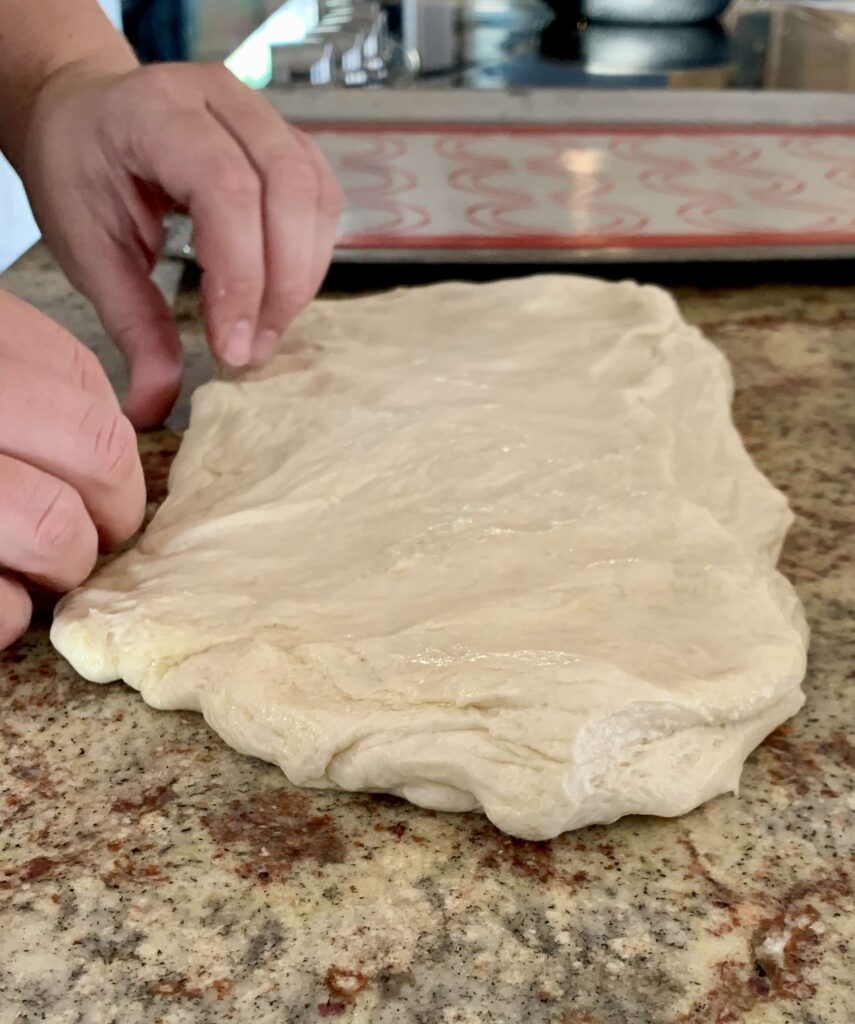
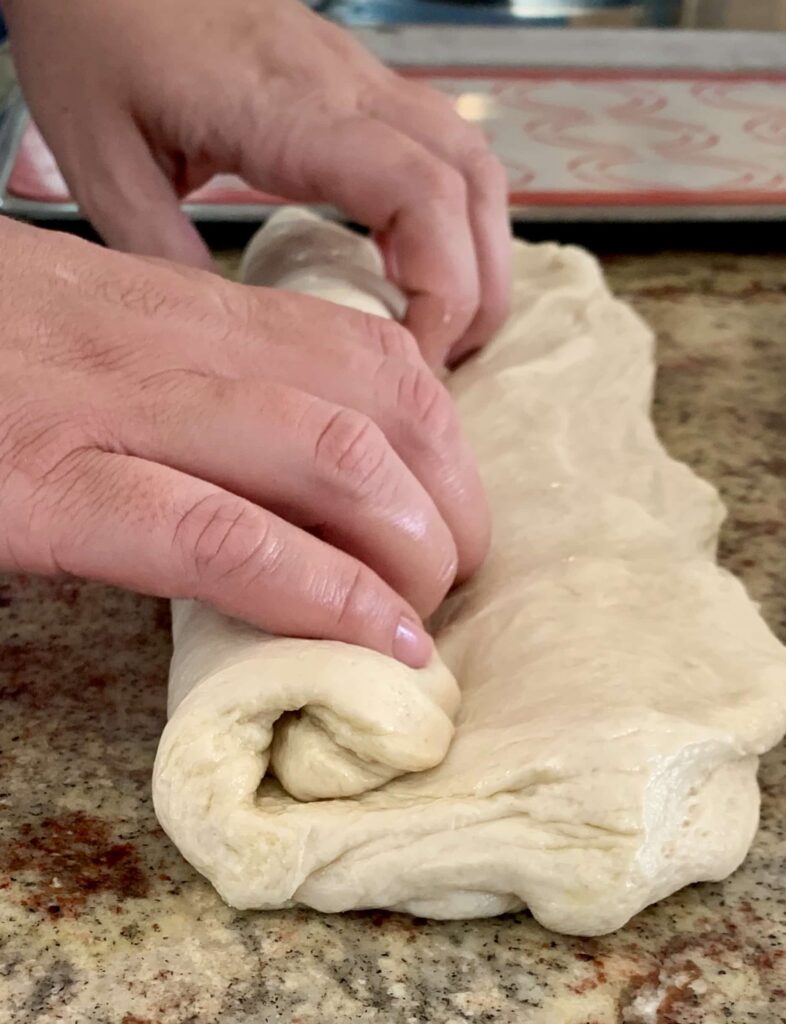


Baking Sourdough French Bread
Pre-heat the oven to 375ºF. Using a sharp knife or a bread lame, score the dough by making quick slashes on the risen baguettes. If you want a crispier crust on your bread, place a handful of ice cubes in a pan and place it on the lower rack of the oven to create steam. As the ice cubes melt, they produce steam throughout the baking process which gives a crispy crust to these sourdough baguettes. If you want softer french bread bake normally. Bake at 375ºF for about 30-35 minutes. Top the fresh bread with melted butter and cool completely before slicing. Enjoy!
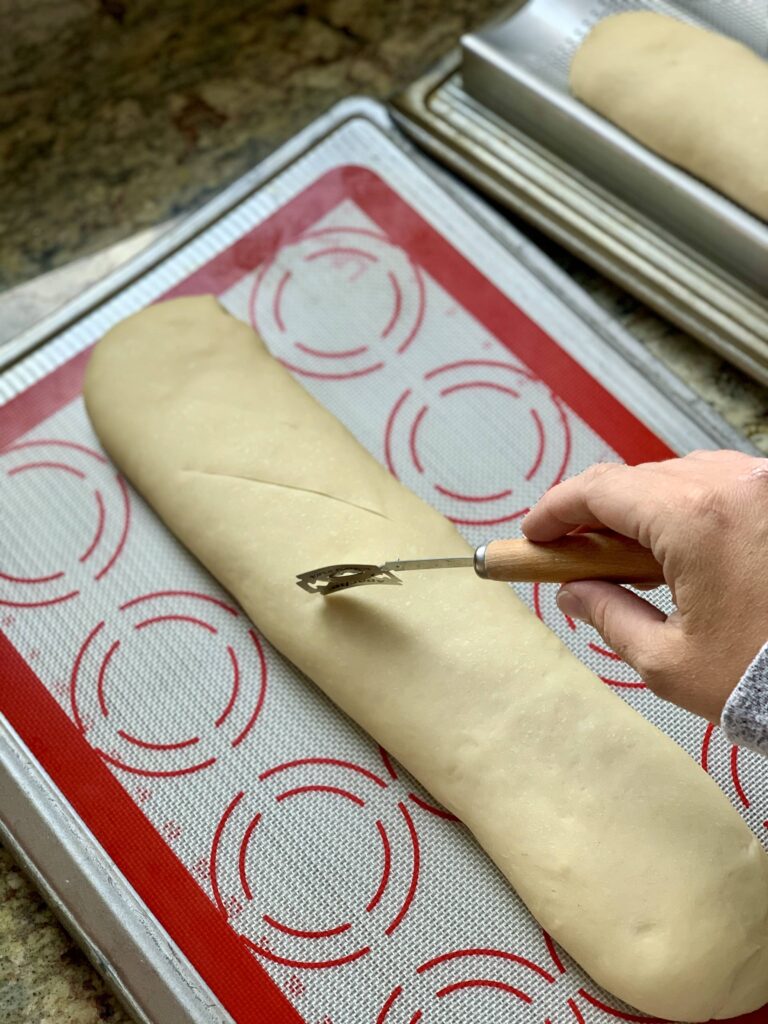
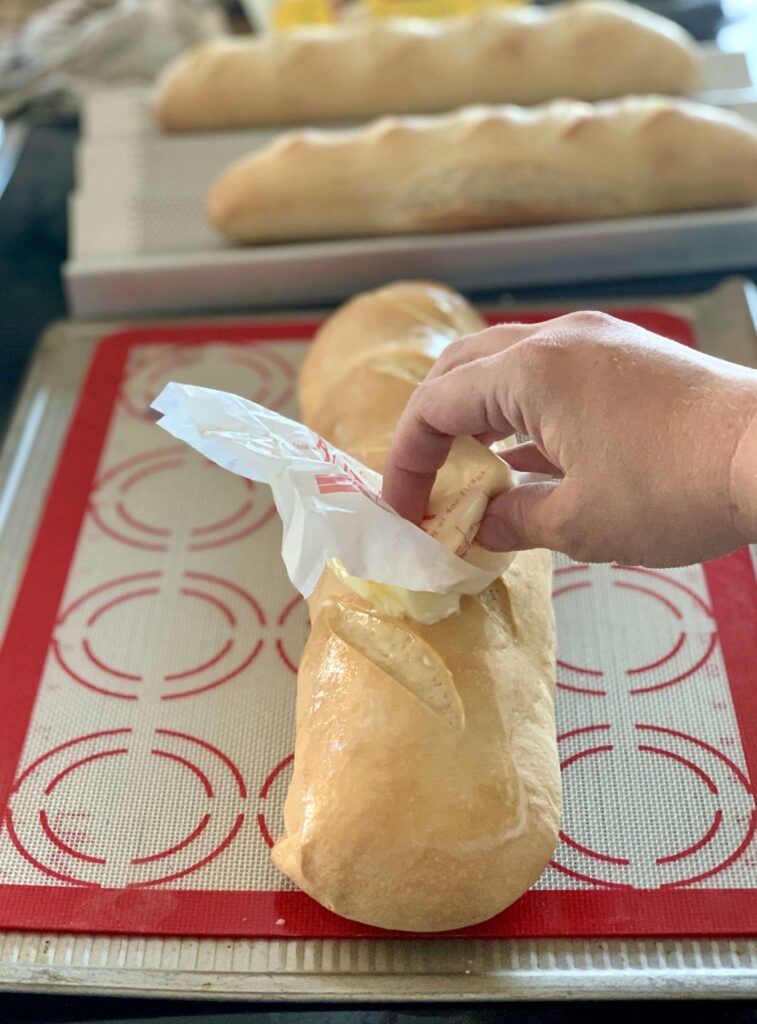
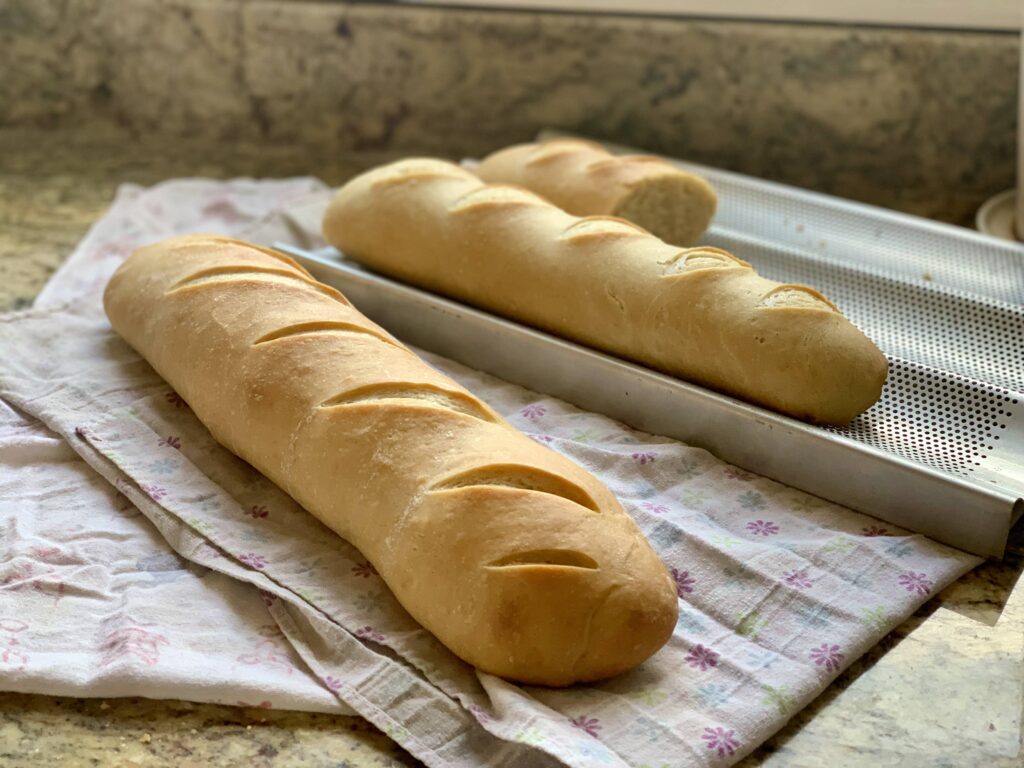
Substitutions
- Bread Flour: If you don’t have bread flour, you can add 20 grams vital wheat gluten to 840 grams all purpose flour. This increases the protein content of the bread and gives your bread a better rise and chewier crust.
- Vegetable Oil: You can substitute any neutral-flavored oil. I really like this recipe with coconut oil or even melted butter works.
How to Store Sourdough French Bread
This bread will store at room temperature for 24 hours. After 24 hours (or once the bread cools), slice the bread and put in a ziplock bag. Freeze sliced bread for 1-2 months before toasting or defrosting and using.
If you liked this recipe, you’ll love…
- Soft Sourdough Sandwich Bread
- No Knead Beginner Sourdough
- Sourdough Baguettes
- Sourdough Artisan Bread
- Sourdough Focaccia Bread
Frequently Asked Questions
Yes. After the bulk fermentation you can refrigerate the dough for 18-24 hours before shaping and baking.
Check to make sure you are using ripe, bubbly sourdough starter. If your starter is active and bubbly, you may need to keep your dough warmer – read all about how temperature affects sourdough here and give your dough longer to ferment before baking. Make sure the dough is almost doubled in size, fluffy and airy before baking.


Soft Sourdough French Bread
Ingredients
Levain: 10-12 hours before mixing dough (overnight)
- 11 grams sourdough starter
- 110 grams all purpose flour
- 110 grams water
Soft Sourdough French Bread Dough
- 200 grams ripe levain
- 430 grams water
- 55 grams granulated sugar
- 24 grams salt
- 70 grams vegetable oil
- 860 grams bread flour see recipe notes
Instructions
Levain (1:10:10, about 10-12 hours overnight at 78ºF)
- Mix together ripe, active sourdough starter with flour and water. Cover and let rise for 10-12 hours at 78ºF until bubbly and ripe.
Soft Sourdough French Bread
- Mix Dough: To the bowl of a stand mixer fitted with a dough hook add the ripe levain, water, sugar, salt, and oil. If the ambient temperature and temperature of the ingredients are below 78ºF, use warm water. If they are above 78ºF, use cooler water.
- Add the flour and mix. The dough should pull away from the side of the bowl, and feel tacky, but not overly sticky. Add a little more flour if the dough is overly sticky, a Tablespoon at a time. Knead the dough for about 8-10 minutes. Alternatively you can knead by hand for 10-15 minutes.
- Bulk Fermentation 4 hours: Transfer the dough to a container. Cover and let rest. The dough temperature should be right around 78-80ºF during this time.
- The dough should rise but not quite double in size during this time. If it does not, take the temperature of the dough and make sure it is warm enough. Let it continue rising in a warm spot until light, aerated and risen a little. At this point you can also stick the dough in the refrigerator after a couple of hours for a long cold bulk rise. See recipe notes.
- Shape: Transfer the dough to a countertop. Cut the dough into two sections for two large loaves or in three for three smaller loaves. Pat the dough into a rectangle and roll up tightly cinnamon-roll style, pinching the seams closed as you roll. Repeat with the remaining loaves.
- Proof: Place the loaves on a parchment-lined baking sheet or use a baguette bread pan. Cover with a kitchen towel or plastic wrap. Let the loaves rise for 3-4 hours at 80-85ºF . Use a bread proofer or your oven with the light on (don't turn the oven on) to keep the dough warm while it rises. If the dough does not rise, do not bake it. Give it some more time and check again. Loaves should be airy, doubled in size, light and puffy before baking.
- Score and Bake: Preheat the oven to 375 degrees. Slash or score the loaves with a bread lame or sharp knife. For crispier bread: Place a handful of ice cubes in a baking pan and place the baking pan on the bottom rack of the oven. Bake the bread for 30-35 minutes until a nice golden color. Brush with melted butter and let cool completely before slicing. Enjoy!

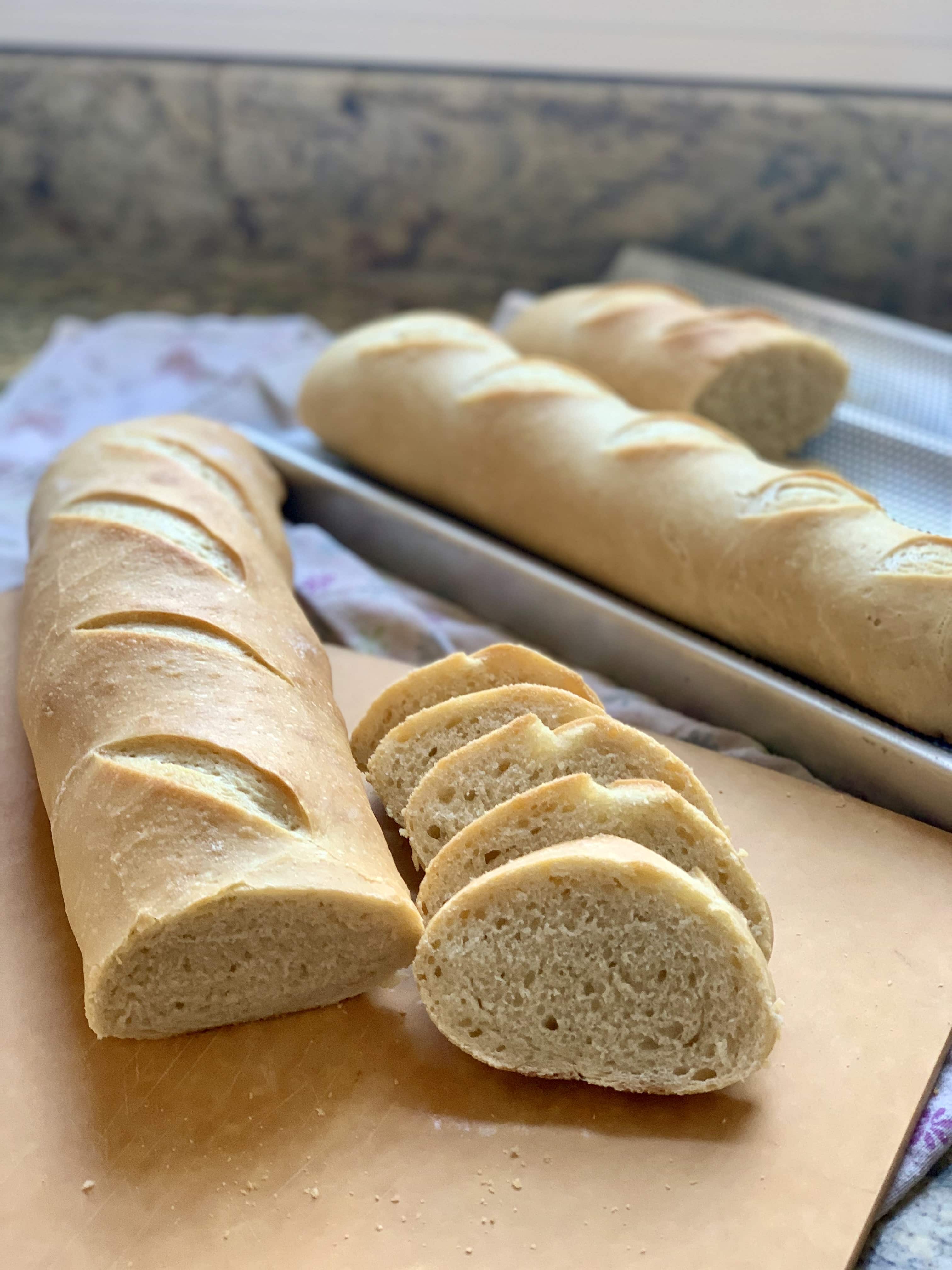


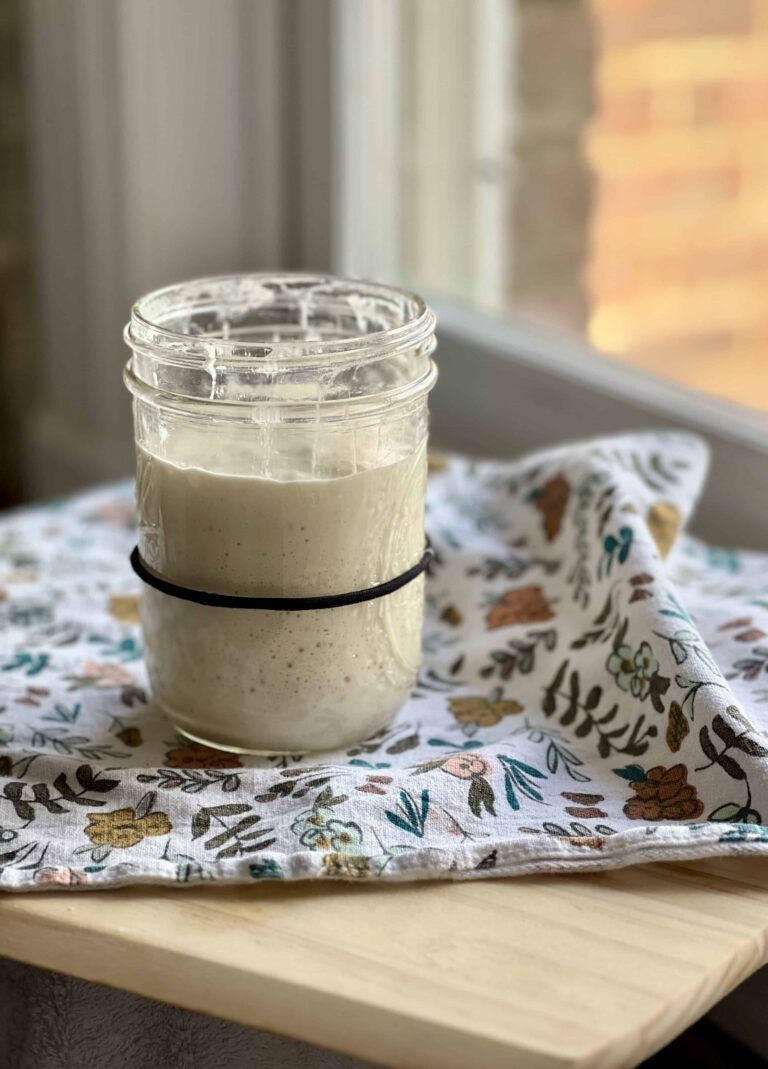
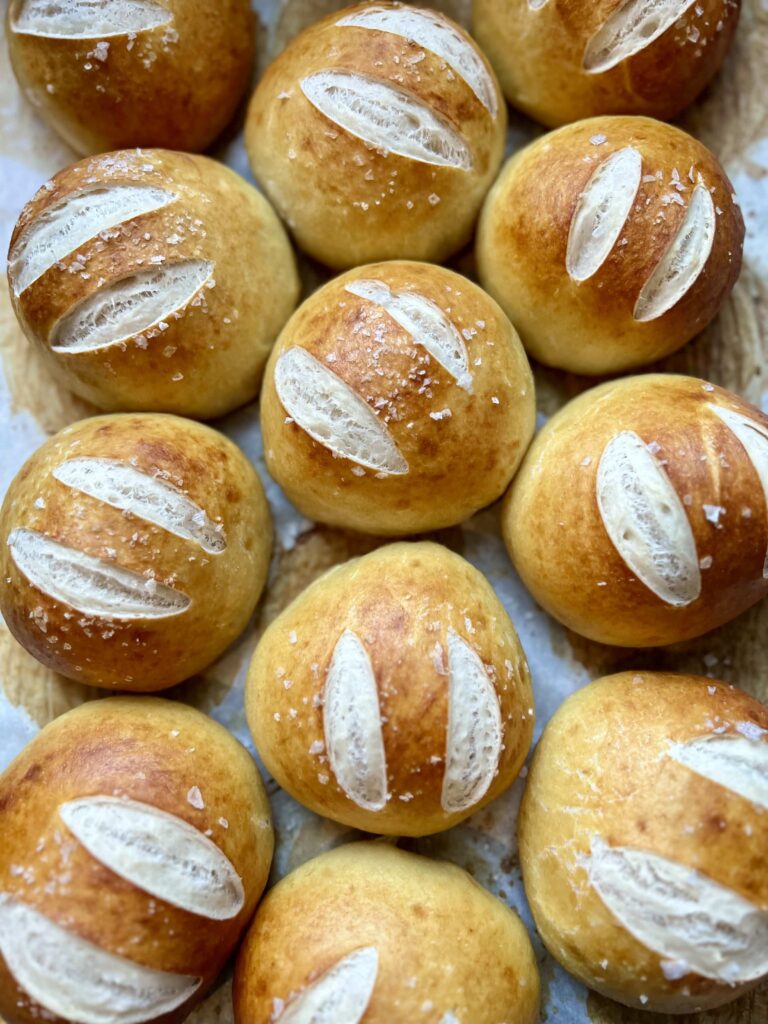

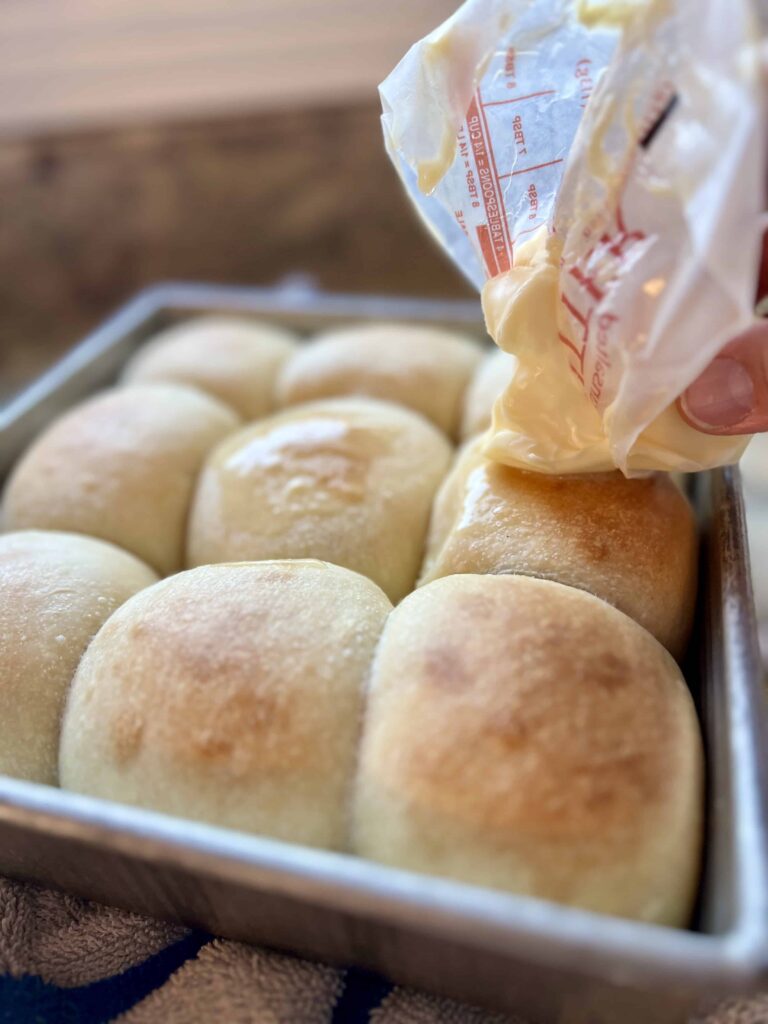
Love your San Francisco memories and your fondue tradition, and love this bread! Happy happy New Year!! 🥖🧀😋🎉